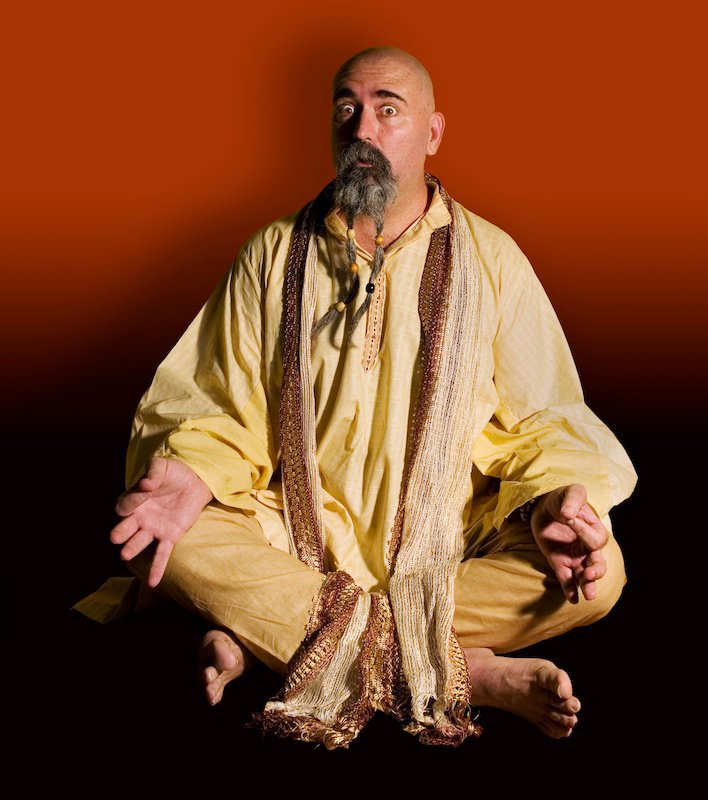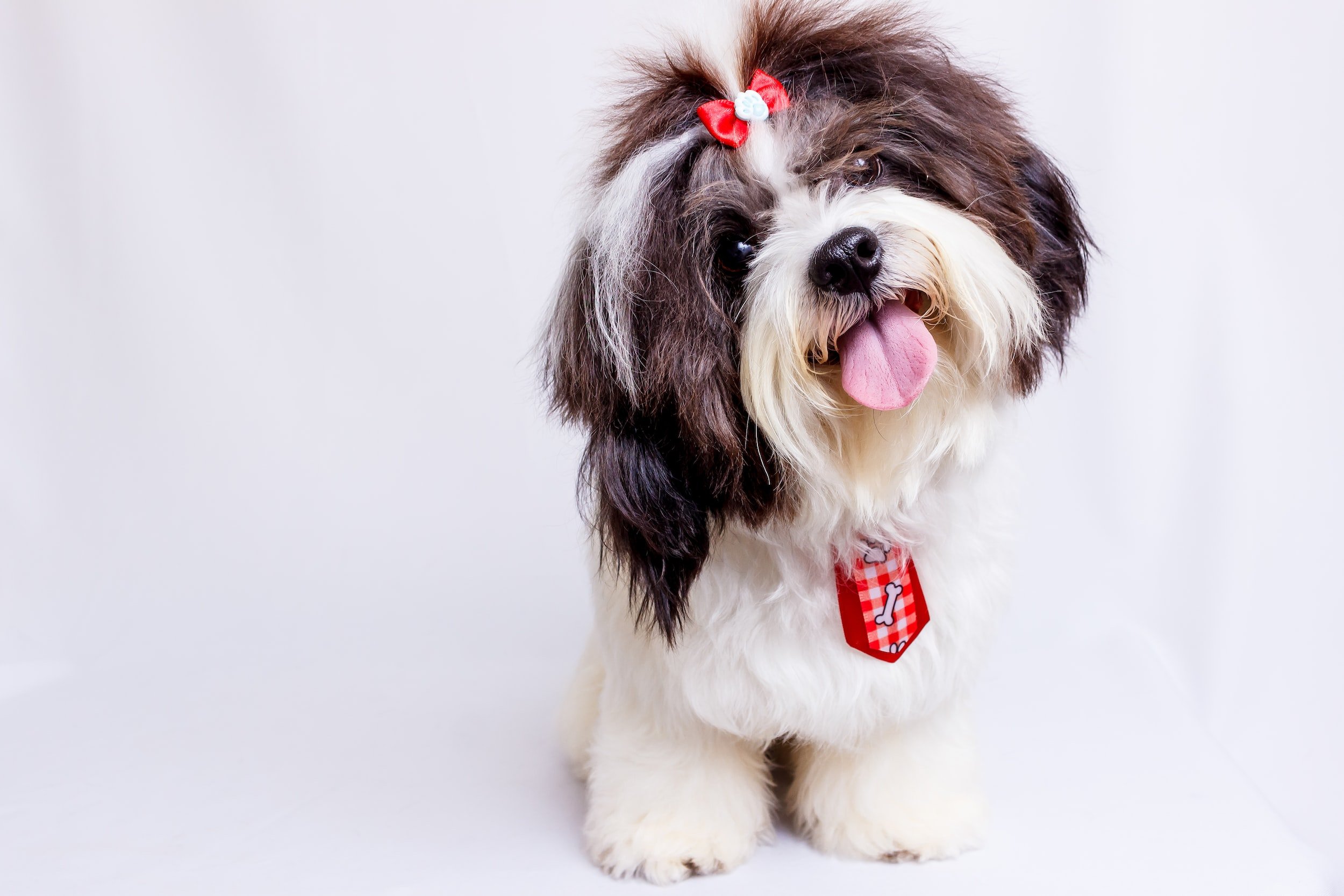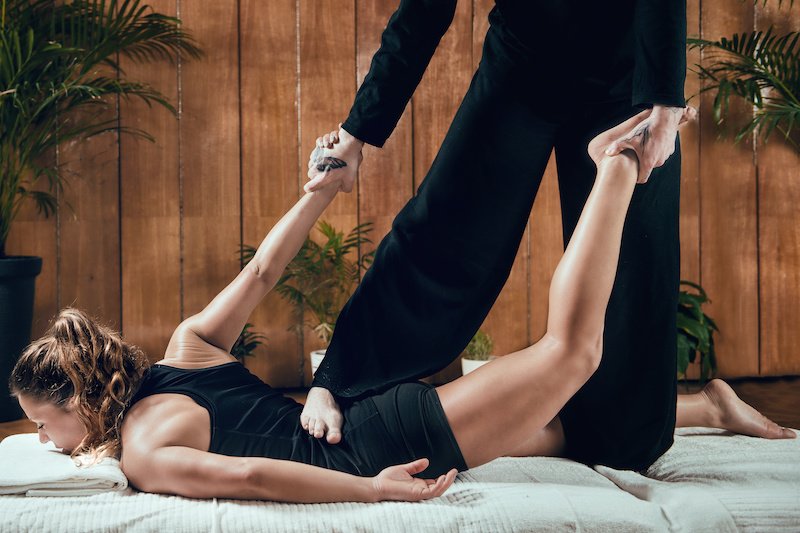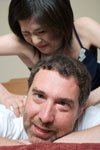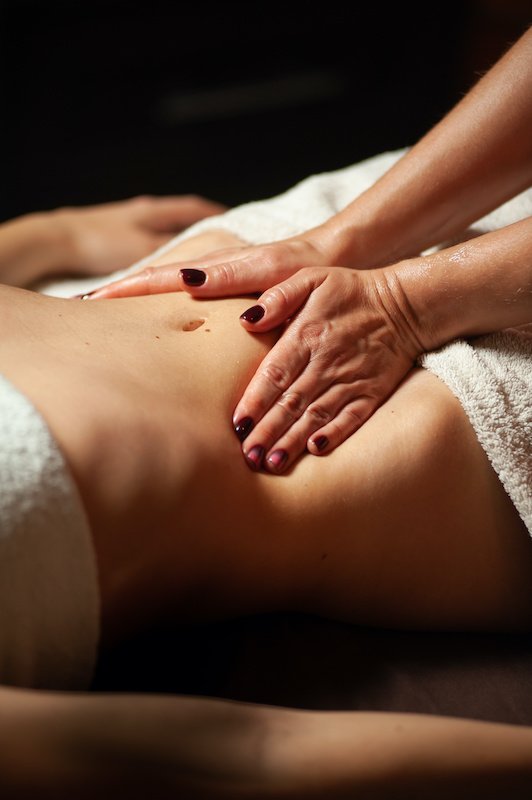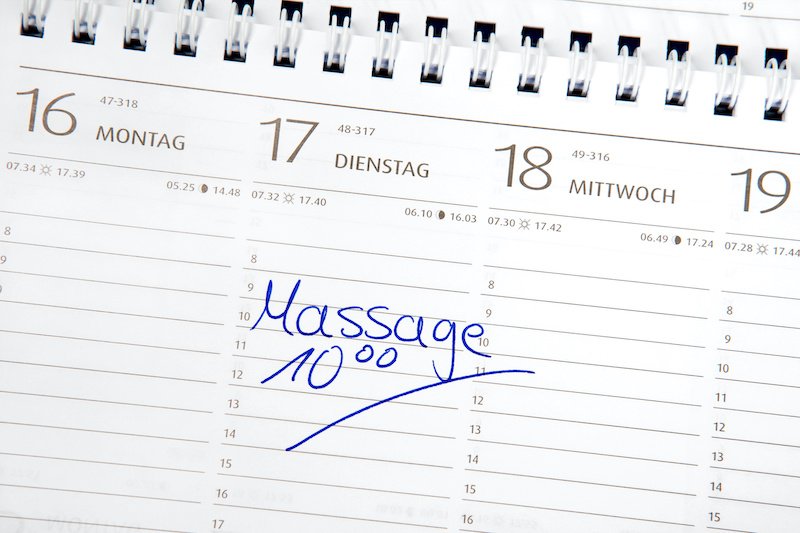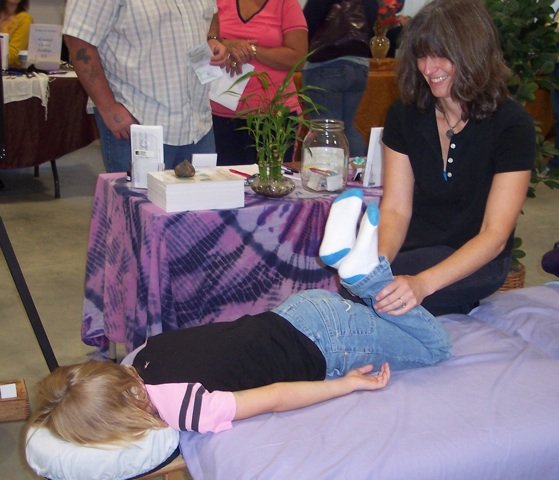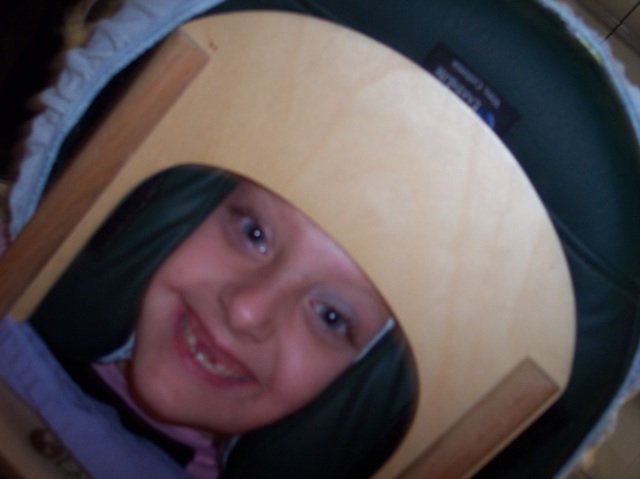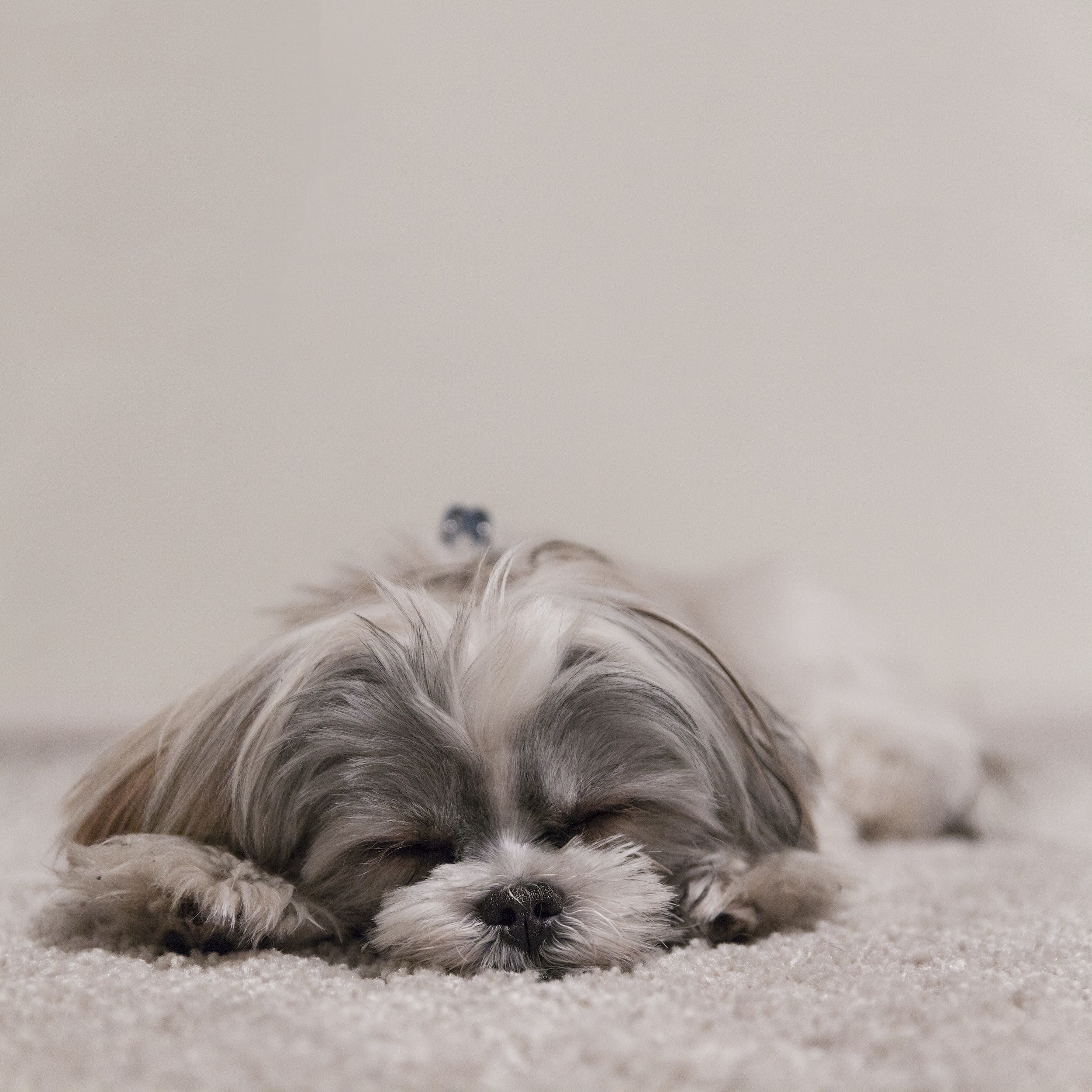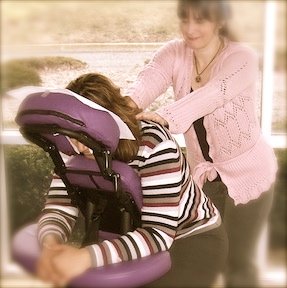
“How do you pronounce shiatsu?”
…. and other FREQUENTLY ASKED QUESTIONS
Question #1: Why this article?
Because shiatsu is fairly (and quite literally) foreign to most folks in the US - especially as compared to 'western massage' - I've complied a list of the most frequently-asked-questions about this Japanese form of bodywork.
Obviously, the best way to get to know it is to try it, but hopefully this will give you a better idea of what it could be like, answer some of your questions if you've had it before, and overall, take some of the mystique out of an otherwise unfamiliar modality.
Most of us are still not used to thinking about massage or bodywork as an effective and safe form of health care, but rather, more of a luxurious, pampering treat.
Plus, modalities with hard-to-pronounce names seem like the indulgences of Hollywood celebrities, or woo-woo type practices.
Shiatsu, and similar manual therapies, have been used in Eastern medical practices - along with herbs, diet, specific forms of exercise, and acupuncture - for centuries.
Not only were physicians trained in some form of touch therapy, but families also passed down this knowledge to take care of their loved ones at home.
I invite you to explore it further.
And, please, if you have more questions than what you find addressed here, contact me!
Question #2: What is shiatsu (and how the heck do you pronounce it)?
This is a shih-tzu. Sometimes confused with shiatsu.
Shiatsu (pronounced shee - ah’- tzoo) is a Japanese word, literally translating as "finger pressure".
It is a form of bodywork (massage) in which pressure given by thumbs, fingers, and palms onto the receiver's skin affects change in the overall body.
You may have come across various styles of shiatsu: “Five Element”, “Zen”, “Ohashi”, “Macrobiotic”. I was trained with a rather eclectic approach that brings in a variety of techniques.
Question #3: How is shiatsu different from 'regular' massage?
Like shiatsu, there are many varieties of 'massage'.
The more common forms that people are familiar with (Swedish, deep tissue, etc) usually involve rubbing oil on an unclothed body, and employing a variety of stroking techniques focused mainly on relaxing muscles and increasing blood circulation.
Shiatsu is usually (but not always) given with the receiver clothed and uses more focused and sustained pressure in specific points and lines (as well as stretching, rocking, vibrating, holding), with the intention of 'moving ki' throughout the body, in order to improve overall health.
Question #4: Uh huh. So, what is 'ki'?
'Ki' (kee - Japanese) ... similar to 'qi' (chee - Chinese), is usually described as 'vital life force', or ‘life force energy’.
It's a concept much more familiar to people in Eastern cultures, though it often sounds weird and woo-woo to many of us in the West.
Ki provides a huge topic to explore, but one possible 'scientific' explanation we can give it, is that it's the 'bio-electric' current that governs all of our cellular processes.
If you're interested in exploring the electric nature of our bodies, check out these publications:
"The Body Electric: Electromagnetism and the Foundation of Life", by Robert O. Becker and Gary Selden*
“The Spark in the Machine: How the Science of Acupuncture Explains the Mysteries of Western Medicine”, by Daniel Keown*
“Is Qi the Same as Energy?”, an article by UK shiatsu practitioner, Bill Palmer (more can be found on his site here).
(*These are Amazon affiliate links, meaning, if you make a purchase through them, I may receive a small commission.)
Question #5: Why would I want to try shiatsu, as opposed to other forms of bodywork?
Everyone will have their preferences, as well as particular scenarios best met by one modality more than another.
And, of course, there are differences between how one therapist might perform their craft and another of the same modality.
But in general, I will say that shiatsu encompasses the best of both worlds: 'body' work, and 'energy' work, in that it incorporates deep and 'massage-y' contact on the body, but also attention to subtle energy shifts.
There are those that really feel nothing after a session (or at least, not what they were expecting). But many others notice an inexplicable and profound 'deeper' sense of relaxation than with massage that seems to last for days after the session.
Also, for those who are more 'tender' (as with fibromyalgia), or concerned about being unclothed, shiatsu can provide a kinder, gentler form of bodywork.
For more about Asian bodywork:
“Asian Bodywork”, article published in MASSAGE Magazine. February 2022;
FAQ’s About Asian Bodywork Treatments, article published by the AOBTA
Question #6: Why are shiatsu sessions often given on the floor instead of on a massage table
Shiatsu, having the Japanese flavor that it does, is traditionally given on the floor, as the engagement of the practitioner's hara figures very prominently into the session.
The hara, being the abdomen and center of gravity, is also believed to be the center of our physical and spiritual energy.
A person is most centered, grounded, and intuitive when 'coming from the hara', as any participant in martial arts knows.
When a practitioner works in this way, not only is it a more efficient use of their body weight to deliver deeper but more comfortable pressure with less energy expended, but they also stay grounded and connected enough with their hara, which provides a kind of intuitive feedback for how the receiver is reacting to the treatment.
Also, a wider range of stretches become possible on the floor.
This is not to say that shiatsu cannot be given on a table. I offer the option for both at the time of scheduling, and the hara can still be used quite effectively, especially if the table is set low enough to provide the right kind of angle.
<= (Note: I don’t try this one too often… :)
For more, see:
Question #7: How do I prepare for a shiatsu session?
People will come in from all points of their lives, and, of course, I will honor wherever they are. But, for the most optimal experience, here is what I suggest:
Shiatsu is a clothed treatment. And, it usually involves some amount of stretching and other mobilization. This is best done with loose, thin and simple clothing. (Zippers, lace, denim, tight waistbands/belts, etc. can get a little hazardous….)
Removing the bra can allow for better access of the band and comfort around the rib cage, but I leave that up to the client.
RE: socks. It’s ‘traditional’ to wear socks during the session, but again, I leave that up to the client. I’m fine either way (though much nicer when either socks or feet are clean.. :)
Refraining from eating too heavily or too soon (within an hour) before the session. I frequently bring in hara (abdominal) massage, which can be uncomfortable after a big plate of pasta. :) Also, a fairly empty stomach allows for the senses and nervous system to be more primed to feel the effects of the work, rather than dulled while digesting.
(And, please note: EVERYONE’S stomach growls - even mine. No need to be self-conscious! It’s a sign your body is relaxing into the parasympathetic mode…!)
If possible, refrain also from strongly-scented perfumes, body care products or detergents. (I understand that this can’t always be avoided.)
Having a sense of intention can be super-helpful for you to get the most out our time together. Of course, most everyone comes in with the story of ‘what hurts’, and why, etc., but I encourage you to consider how you want to feel - during and after, and maybe how you can see yourself expanding this feeling into the rest of your day. This can also help me support you, as the ‘mind leads the Qi’.
Question #8: Why are some spots really tender when they're pressed?
There are some commonly addressed points that are typically tender for most people, such as the outer thigh, or just below the outer elbow crease (known in acupuncture as 'ache' (ah-shay) points, or "ouchy", if you like :).
To be quite honest, I have not yet found a clear explanation as to why these points are typically tender from a shiatsu perspective, except to say that if it is tender, then you've found the right spot!
There is probably a more logical explanation from a western physiological perspective ... something to do with muscle tightness, trigger points, or even lack of regular usage.
In general, though, tenderness will usually signal to the practitioner a place of stagnation or deficiency, and an indication to use a dispersing or tonifying technique accordingly.
This type of soreness should be held just below the pain threshold for the receiver ... strong enough to facilitate an opening and release, but not so much to create tension and resistance.
If the pain is too much, or is felt as radiating pain, the practitioner should be notified right away.
While shiatsu is intended to trigger the relaxation response overall, it can be of profound benefit to have one's comfort level challenged a bit.
Touching the tender spots (usually areas of deficiency) and gently stretching the boundaries of range of motion allows for greater circulation, movement, flexibility, and availability of response options overall.
Question #9: Why does the shiatsu practitioner sometimes press on my abdomen? Is this really necessary
From the practitioner's perspective, palpation of the hara is a highly effective diagnostic tool.
All of the meridians are represented in the abdomen, and pressure on each of these areas gives information as to where the receiver's energy is stuck or weak, as well as allowing for treatment at the same time. One could perform a complete and effective treatment session on the hara alone, and traditionally, an entire lifetime could be spent cultivating a sensitivity to the subtleties of what is revealed about a person's past, present and future health condition just in their hara.
Also, the hara is believed to be the container for our spiritual energy.
Indeed, the energy of the hara can be visualized like a spiral... all forces converging there and spiraling out again, and its wholeness and strength also determines our ability to manifest what we can visualize in our lives.
In a shiatsu session, massaging the hara has a way of unifying and integrating all parts of the treatment together.
Also, when one describes their lives or energy as feeling "scattered", hara treatment can bring back a feeling of wholeness or centeredness.
One more benefit, from a structural perspective, is that addressing tension in the abdomen can have the immediate effect of relieving back and hip pain, as well as constrictive digestive or menstrual issues, as the fascia connecting these areas softens and relaxes under gentle but deep pressure.
There are certainly a wide variety of reactions to this aspect of shiatsu treatment, and there are a couple reasons why the treatment of this area, the hara, comes into shiatsu sessions.
Diagnosis and treatment of the hara ('ampuku', in Japanese) had been an integral part of Japanese medical treatment up until the 19th century or so.
As the abdominal area was seen as the embodiment of a person's character and entire life history, it was inconceivable for a doctor to treat a person without understanding this context. One of the reasons shiatsu became established as it did, as a therapeutic modality, is because it brought ampuku back into the treatments.
Question #10: One time, a shiatsu practitioner felt my pulse and looked at my tongue. What was that all about?
Feeling the pulse and checking the tongue are diagnostic tools used in ancient Chinese medical systems.
The information gathered from these methods is used to create a picture of the client's 'condition' as understood through Chinese medicine.
There are a variety of other ways to tune into a person's state of health, including facial diagnosis, muscle testing, signs exhibited by a person's voice, breathing, complexion, posture, hara diagnosis, palpation, and, of course, asking.
As my style and training is more aligned with the Zen school of shiatsu, I tend to rely on palpation and responsiveness of the meridians through stretching for my information. Neither method is superior to another ... I have just found that I am more receptive to the information I gather through actually working on the person, but I do, at times, incorporate a variety of means to develop a picture of the receiver.
Question #11: Also, I was told something like my 'liver chee' was out of balance. Should I be worried?
Harkening back to the above reference of 'ki' as this life force or current that flows through the body, the theory is that it flows more or less along particular channels.
Each of these channels has a association with an Organ, organ system or function, and have been named - in the West - according to the organs (somewhat inaccurately) as we know them (another casualty of cross-cultural translation...).
This distinction is made in print by capitalizing the meridian channel 'Liver', as opposed to 'liver', the actual organ. This 'flow', as discerned by a shiatsu therapist, can be described as blocked, stagnant, in excess, deficient or something similar.
This flow may have some bearing on the actual organ, but usually it is descriptive of an overall condition, a way that your Qi is organizing your body around your engagement with life, and other information about the harmony between your parts.
In some cases, extreme imbalance can lead to more serious conditions, but that’s beyond the scope of this article. :)
Question #12: Sometimes, I've noticed that you (or another practitioner) will just hold my arm out for a while. What's up with that? Are you really doing anything?
This is a technique currently understood as 'unwinding the fascia'.
(I phrase it this way, as there are some debates as to what is actually happening.)
Suffice it to say that when there is tension in a part of the body - particularly in a place that commonly holds tension: shoulder, hips, etc. - a person's habitual response is to hold the tension, or even 'help' when the practitioner is trying to rotate or relax the area. It's almost impossible for the receiver to consciously 'let go'.
By placing the limb in a particular position and 'suggesting' traction, rather than am outright stretch, it's like going under the radar, and another system in the receiver's body (likely, the proprioceptive) takes over and finds the opening in the tissue just below the receiver's awareness.
Sometimes nothing happens. Sometimes it can be quite dramatic and profound, such as release of tension brought on from trauma, or just overuse.
It’s an interesting way of ‘holding space’, while allowing your body’s own intelligence to take over and find its way back to ease.
Question #13: How often should I get shiatsu?
Ah. The million-yen question. :)
The standard answer is, it depends.
It depends mostly on what role and priority you see bodywork having in your life (whether shiatsu or otherwise).
Some people come in one or more times in close succession to address something acute that has happened: an injury, an illness, a major life change. In these cases, they will come in every week or so until they feel better.
Others come in weekly, every two weeks, once a month, or once a season for maintenance, or to balance what's going on in their crazy lives. And others show up, as needed, every few months or once a year.
Obviously time and finances are a factor, but I know for myself (also being a bodyworker), every two weeks is the ideal. (I did try once a week, but I found that the sessions did not feel as effective with that frequency - as luxurious as it seemed.
The more a person meets the sessions with awareness and intention, and especially when engaging in other mind/body practices, the more the ‘call’ for shiatsu becomes for support and deeper opening, rather than putting out the fire of pain and overwhelm.
Question #14: What can I expect to feel after a session?
Most people report a deep sense of relaxation. Beyond that, results may vary. :)
Shiatsu is funny, in that sometimes, a particular pain or ache will be immediately relieved.
Other times, it's more subtle, or takes time to reveal itself.
I've heard: 'better sleep', or even 'more restless sleep the first night, followed by better sleep'; surfacing of old memories, a calmer stance in the midst of typically stressful situations, more energy, a sense of floating, 'mental flexibility', 'fitting into my skin again' ... and similar things.
It’s been my experience that people who engage in other mind/body practices, and/or are alert to what is happening during the session will be more attuned to the subtle (and not so subtle) changes in their state in the hours and days after the session.
Question #15: How can I maximize the effects of shiatsu (during and after my session)?
While there is some debate as to whether or not it's okay to fall asleep during a session (see below), I do encourage folks to pay attention to what they're feeling, if they're not otherwise dozing off, or 'traveling' :).
There's a belief that the 'ki' (life force) follows the mind, so if the 'ki' is actually helping your body heal, your awareness of my touch would be drawing 'ki' to those areas in the body that need it.
Many of us are not connected to our bodies, beyond pain and discomfort, and even then, we try to turn our attention away from it. But there is a place for focusing on tender places, and it can help to transform them. I also believe that paying attention in this way can cultivate a sense of curiosity, awe and appreciation about our own bodies that heals our relationship to them.
Continuing this mindfulness after the session will help you become conscious of some of the habits and responses that create this tension and imbalance in the body to begin with.
Pay attention to how you feel, what emotions arise, how you may be responding differently in stressful situations. Beyond that, drink water, sleep if you feel called to, or even, move the body, if that feels right.
As mentioned in the question above, the more consistently one engages in other mind/body practices, the greater bang for the buck.
I do offer instruction in forms of exercise and meditation that complement shiatsu, which you can perform on your own for maintenance.
Question #16: When would it NOT be a good idea to get a shiatsu treatment?
There are very few situations in which shiatsu would not be a good idea, particularly because the pressure can be adjusted to even be as light as barely touching the body.
But these are guidelines under which shiatsu should be avoided, or at least discussed with your medical care provider first ( and then notifying your shiatsu practitioner of your condition):
• Acute active stage of cold or flu
• Any acute condition or serious disease (check with doctor first.. if they unclear as to what shiatsu is, ask if it's okay to get massage or acupuncture)
• Untreated high blood pressure, heart rhythm issues or diabetes
• Cancer. There are varying schools of thought about this. On the one hand, the idea that shiatsu has the function of moving energy gives rise to the theory that this could cause the cancer to spread more quickly. On the other hand, it is believed that very gentle and short sessions (combined with the practitioner's purest intention not to harm) can support the body's immune response, relieve the overall stress caused by the illness and the medical treatments, and relieve some of the side-effects, such as nausea, caused by chemo and radiation. Once again, it is best to consult with a doctor, use good judgement, and gauge the comfort level of the receiver and the practitioner.
• And under NO circumstances should a person under the influence of drugs or alcohol receive bodywork.
Other conditions should be brought to the awareness of the practitioner during the intake process, or before beginning a session if there has been a change in history:
• Osteoporosis, or recent broken fractures, broken bones, sprains
• Open wounds, recent scars, bruises, varicose veins, inflammations or sores that might be hidden by clothing
• Early pregnancy (first trimester)
• Contagious illness
If there's ANY kind of question in your mind about something going on with you, and would shiatsu be appropriate, PLEASE ASK!!!
Question #17: Can pregnant women receive shiatsu?
Absolutely!
Shiatsu has the marvelous ability to open all the energy channels to support the mega-hormonal changes occurring during this time, relieve the multitude of discomforts of pregnancy - both physical and emotional, calm stress, and stimulate and nurture the bond between mom and baby.
Even during labor, there are amazingly effective points used to stimulate labor, and make the whole process smoother and more efficient. Shiatsu is great for after labor as well...
On that note, it is really important that, if you are in early pregnancy (and it's not apparent to your practitioner), or you are trying to get pregnant, that you make it known to your practitioner.
These powerful points will then be avoided, and a different approach to the session will be taken to maintain the energy in the hara, where the baby is brewing.
Question #18: Can children receive shiatsu?
Yes, they can!
Most children love bodywork, and it can be incredibly beneficial in supporting relaxation, a sense of calm, better sleep patterns, improved focus, and development of an awareness of the body/mind connection.
Of course, children will respond to receiving shiatsu in a variety of ways... some are very comfortable with touch (and touch of a stranger can be challenging to some), some are quite ticklish, and there are a few who need some time to relax into this kind of relationship.
I have approached these situations creatively: offering very short treatments, allowing the young person to bring music they liked, spending time talking with them both before, during and after the session, using very general pressure - sometimes in just one 'safe' area, like the back.
I have demonstrated to mom how to do some basic movements on the child, if that felt better; in one case, I actually just worked on mom, with little one going between looking on and exploring my office! Even babies can enjoy the benefits of touch therapy, and shiatsu can be helpful in relieving many of the discomforts of infancy.
It's wonderful to see children make the connection between how they feel physically and emotionally, and they often readily take to skills such as breathing mindfully to calm themselves down. (Not to mention, their own attempts to give shiatsu to mom or dad!)
Question #19: Sometimes I have felt drowsy or light-headed after a session. Is this normal?
Yes, one can expect a variety of responses like these after a shiatsu (or any bodywork) session.
Energy is getting stirred up and moved in ways that it may not typically be; or the deep relaxation that comes during the session may take some time shake.
In addition to that, because otherwise chronically tense muscles be relaxing for the first time in a while, and with the pressure being taken off blood vessels, the pressure can drop. Usually with some water, and a little walking around, preferably on grass or near trees, these sensations will pass. (I also keep a dish of ginger candies on my desk, which has a nice effect of grounding ... sweet is the flavor of the Earth element)
However, if these feelings persist, seem like they may impair your ability to drive, or are very uncomfortable (like nausea, or disorientation), let your practitioner know right away.
Question #20: Sometimes I doze off during a session. Is that okay?
Yes, it’s fine….
Though as I've said above, it’s sometimes better for a person's healing abilities if they are more 'present', engaged and aware of how their body is receiving the work.
However, I have found that with more and more people struggling with insomnia and erratic sleep patterns, the sessions provide the most relaxation they've had in weeks.
Some people may be uncomfortable with the idea of being vulnerable in such a situation ... that is, asleep while someone is doing bodywork on them.
Completely understandable.
While I also consider dozing off as a sign of temporarily relinquishing control (a good thing when you're trying to relieve stress!) and an offering of trust , some people may have difficulty walking that line between staying awake to avoid feeling vulnerable and letting go completely ... the latter, of course, being ideal for the healing process. (Not that letting go necessarily means that you'll fall asleep!)
If this is a concern for you, please discuss this, as we can find ways to allow to relax as much as possible within your comfort level.
The flip side of the same coin: Talking through a session.
Again, there’s a place for chatting, sharing feedback, asking questions, etc. But I have found that sometimes this can prevent a person from going ‘deeper’ into the experience of the session. In some cases - and often unaware to the receiver - that’s kind of the point: to stay on the surface, perhaps due to trauma, or other reasons for disconnecting from the body.
I try to meet you where you are, and again, if you have thoughts or concerns about this, I am open for discussion about it. The most important thing is that you feel safe and in consent and advocacy for your own needs.
Question #21: Do you offer other things besides shiatsu?
I do!
I offer several services that can be stand-alone or added on to a session:
Ginger compress. This is traditional Japanese treatment that involves applying towels soaked in hot fresh ginger water to areas that are stiff, stagnant, and could use some help with circulation (like the low back, shoulders, etc). You can read more about that here.
Acupressure Facial. With 40+ muscles in the human face, we can generate a surprising amount fo tension here. My facial massage touches on these muscles, as well as acupressure points that can aid with clearing congestion, headaches, jaw tension, ear stuffiness and more. I also work on the neck and shoulders, to provide relief here, as well as support lymphatic drainage.
Foot Massage. Another lovely treatment for those hard-working appendages. I start with a hot water scrub and then a light application of coconut oil while massaging and mobilizing many of the 33 joints in the feet. I can also work on the hands!
Movement ‘coaching’. Also, as I want to support people ‘beyond the bodywork’, I offer movement and embodied meditation - both of which can be incorporated within a bodywork treatment, or as a private or group class.
Question #22: Do you make house calls?
For practical and safety reasons, I do not offer 'house calls' in general.
However, I know that there are some cases in which a house visit would be much more feasible to the client.
The factors determining whether or not I would make a house call are: my familiarity with the client, the client's cooperation and ability to have a quiet, adequately roomy space for a treatment, and geographical location. (I would include a travel fee in addition to my regular fee, and in some cases, may ask that two or more clients be lined up to make it worth traveling the distance.)
Also, I can offer shiatsu chair massage at your office or event. Contact me!
Questions #23: How can I stay updated on your offerings?
I’m so glad you asked!
You can subscribe to my periodic emails, ‘gracenotes’, wherein I share thoughts and theories related to bodywork, movement, seasons, life changes, etc., as well as upcoming classes, events and other cool stuff I’ve found.
Your info is safe with me and you can unsubscribe at any time.
